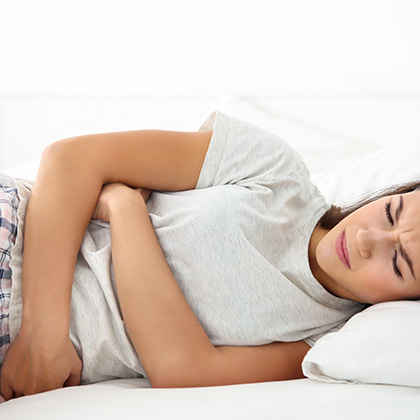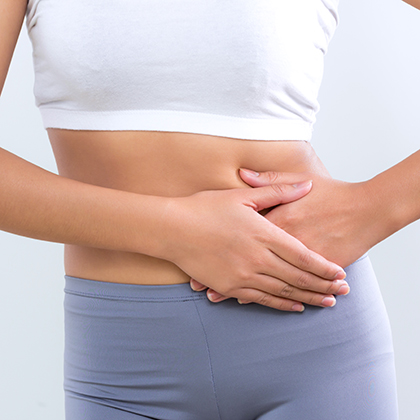As their name suggests, gallstones are small stones that form in the gallbladder. They can be made of hardened cholesterol or of solidified calcium and bilirubin (a pigment found in red blood cells), or they can be a mixture of the two.
The NHS estimates that more than one in every 10 adults in the UK has gallstones, which makes them very common (i). Your risk of developing them increases as you get older. You’re also more likely to get them if you’re a woman (it’s thought that twice as many women than men develop gallstones at some point in their lives), if you’re overweight or obese, if you’ve recently lost weight, if you are pregnant, if you have diabetes or if gallstones run in your family (ii). Find out the facts about weight loss here.
But why are some women twice as likely to develop gallstones than men? Some experts believe oestrogen has a role to play in this, with studies suggesting that the increased risk for gallstones in women may have something to do with how the liver metabolises cholesterol in response to oestrogen (iii)..
Gallstones symptoms
The good news about gallstones is that most people who have them don’t develop any symptoms, which mean they may never know about them. Some may discover they have gallstones when they have tests for another condition. But unless they’re having any gallstones-related symptoms, they won’t usually be advised to have any form of treatment for them.
If, however, a gallstone blocks one of the bile ducts – tubes that carry bile from the liver to the gallbladder and from the gallbladder to the intestine – it can cause the most common gallstones symptom: abdominal pain (uncomplicated gallstone disease).
Known as biliary colic, this pain is caused by contractions as the gallbladder tries to pass the stone. It can start suddenly and last between one and five hours (or, in some cases, longer). It can also be mild – like mild indigestion – or severe, and is most often felt in the centre of your abdomen or below your right ribs. Thankfully, biliary colic doesn’t happen frequently, and you may not have another episode for weeks or months.
Meanwhile, in cases of complicated gallstone disease, where a gallstone blocks the flow of bile for longer or migrates to another organ such as the pancreas, more serious complications can arise, including the following:
-
High temperature
-
Persistent pain
-
Increased heartbeat
-
Jaundice (yellowing of the white of the eyes and skin)
-
Itchy skin
-
Sudden chills, shivering and high temperature
-
Mental confusion
-
Loss of appetite
If you have gallstones and experience any of these symptoms, see your GP as soon as possible (see your doctor immediately if your abdominal pain is intense or lasts longer than eight hours, if you have jaundice or a high temperature and chills).
How your gallbladder works
Your gallbladder is a small pouch of around three to six inches long that’s found under your liver, below the right side of your rib cage. It stores a substance called bile – a yellow-green fluid made in your liver that contains water, cholesterol, phospholipids and bile acids (chemicals that are needed for digestion).
Bile helps your body break down the fat in your food into small droplets that can be absorbed. It also helps your body to absorb fat soluble vitamins from the food passing through your digestive system, and contains waste products that are excreted through the bowel.
The bile from your liver travels along small tubes called bile ducts into your gallbladder. When it’s needed for fat break-down – after you eat a meal, for example – bile is released from the gallbladder back into the bile ducts, where it passes through to the duodenum (the first part of the gut after the stomach).
Gallstone formation
When the chemicals found in the bile inside the gallbladder become unbalanced, tiny crystals can develop and gradually turn into one or more gallstones (though it can take many years for these crystals to turn into stones):
-
Cholesterol stones develop when you have more cholesterol in your bile than bile acids, making the cholesterol in your bile hard and solid. Studies suggest that dietary factors may increase the risk of cholesterol gallstones forming, including eating sugar and saturated fat, while other factors – eating fibre, for instance – may reduce the risk (iv).
-
Pigment stones consist of calcium and bilirubin, a pigment found in broken-down red blood cells. They can form in bile when the level of bilirubin is too high, as in medical conditions such as sickle cell disease.
You can also develop gallstones when the flow of bile slows down as a result of liver damage or damage to the biliary tract, or if you have been fasting for a long period (when the flow of bile naturally slows down because it isn’t needed to help with the break down and digestion of fat).
One or more stones can develop in the gallbladder without causing any problems. But sometimes a stone becomes lodged in the cystic duct – the duct between the gallbladder and the bile ducts. And when the cystic duct contracts to try and push the stone out, it can cause abdominal pain (biliary colic).
If a gallstone gets stuck in a bile duct, on the other hand, it can block the flow of bile from the gallbladder to the duodenum. The bile then leaks into the blood, causing the symptoms of jaundice. If, however, a gallstone causes an obstruction where the bile duct joins together with the pancreatic duct (just before they open into the duodenum), it can cause inflammation of the pancreas, otherwise known as pancreatitis.
Treatment for gallstones
For most people with gallstones, no treatment is necessary if they only cause a few or no symptoms. In these cases, doctors recommend active monitoring (or watchful waiting). This means your GP will monitor you to find out if any symptoms develop – and if they do, to see how far they progress.
Some people with gallstones never develop any symptoms whatsoever. Some may have one mild attack of biliary colic (abdominal pain caused by gallstones) and nothing else. Others, however, may experience pain every few weeks or months, for which they may be prescribed painkillers.
Medication is available that dissolve small gallstones that don’t contain calcium, called ursodeoxycholic acid tablets. These aren’t used very often because they aren’t always very effective, and the gallstones can come back when you stop taking them.
Gallbladder removal
Surgery is only necessary if you get frequent and severe symptoms that increase your risk of developing complications such as cirrhosis of the liver, high blood pressure inside the liver (portal hypertension) or diabetes.
You may also need gallbladder surgery if tests have shown you have high levels of calcium in your gallbladder, as it can lead to gallbladder cancer later on. Gallbladder removal can also be performed if you have acute inflammation of the gallbladder.
Gallbladder surgery may include removing the gallbladder altogether, usually by a keyhole procedure called a laparoscopic cholecystectomy. Other types of surgery include the following:
-
Open surgery
People who are obese, women in the final three months of pregnancy and those who have an unusual gallbladder or bile duct structure may need open surgery to remove their gallbladder rather than keyhole surgery. -
Endoscopic Retrograde Cholangio-Pancreatography (ERCP)
This procedure – which is usually carried out under sedation rather than general anaesthetic – removes gallstones from the bile duct, leaving the gallbladder intact.
Gallstones prevention
The NHS says there is some evidence that changing your diet and losing weight (if needed) may help prevent gallstones (v).
Cut down on fat
A healthy balanced diet is essential for all-round good health. And avoiding eating too many foods with high levels of saturated fat may help prevent gallstones, since cholesterol is a key factor in their formation. If you already have gallstones, there is no specific diet you should follow – but eating healthily and cutting back on fat may help to reduce your symptoms, especially if you tend to experience problems after eating.
Try to choose lower-fat alternatives when you go food shopping – for instance, go for skimmed or semi-skimmed milk instead of whole milk, and look for low-fat versions of foods such as yoghurt, cheese and salad dressings (but be aware that may processed foods that are low in fat can contain high amounts of sugar).
Also try cooking with less fat – ideally, use a spray oil if you have to use fat for frying (try baking, steaming or grilling instead). Taking the skin off meat and choosing leaner cuts can also help reduce your fat intake.
Lose weight if you need to
If you’re overweight – and especially if you’re obese – it’s likely you’ll have a higher level of cholesterol in your bile, which can increase your likelihood of developing cholesterol stones in your gallbladder. Losing weight can reduce your risk, but not if you lose weight too quickly (rapid weight loss has been linked to the development of gallstones). Your GP can advise you about losing weight more slowly and steadily at a rate of around 1-2lb per week.
Stay physically active
Exercise can help you to maintain your weight, plus it may also help prevent the formation of gallstones by improving bile flow. Aim for 30 minutes of moderate-intensity activity – where you feel warm and slightly out of breath – five times a week (or 150 minutes a week).
Give up smoking
Some research suggests that smoking increases the risk of developing gallstones (vi). If you need help with quitting, there are products available that can reduce your nicotine cravings, such as patches, lozenges and gum. Read our tips on how to stop smoking here.
Natural support for gallstones
Eating a low-fat diet may help reduce your risk of developing gallstones. Some natural supplements may also be useful, particularly those that are thought to protect against gallstone development by breaking down and lowering bile cholesterol.
Vitamin C
Researchers writing in the journal BMC Gastroenterology have found that people who take regular supplements of vitamin C may be less likely to develop gallstones (vii), with Spanish researchers suggesting that vitamin C may help modify the bile cholesterol crystallisation process, which is the first step in cholesterol gallstone formation (viii).
There’s also some evidence to suggest using vitamin C supplements on a regular basis may help prevent gallstones in women (ix).
Lecithin
Many natural health practitioners also believe that lecithin – a natural substance found in foods such as soya beans, eggs, milk, peanuts and some fruits and vegetable – may help reduce cholesterol, which in turn may prevent gallstones. Indeed, one study suggests a soya lecithin powder may reduce cholesterol absorption and lower LDL (‘bad’) cholesterol when added to fat-free foods (x).
FOS
You may also want to add more fibre to your diet by taking a natural fibre supplement such as fructo-oligosaccharides (FOS). Many experts believe those who have a high-fibre diet are less likely to develop gallstones than people who don’t eat much fibre, as the consumption of dietary fibre may help to lower cholesterol.
A report in the journal Current Medicinal Chemistry, for instance, suggests that a high intake of fibre – among other things such as monounsaturated fats, oily fish, vegetable protein, fruit and vitamin C supplements – may help protect against the development of gallstones (xi).
FOS is found naturally in foods such as asparagus, Jerusalem artichoke, leeks, onions and soya beans.
Following these tips on gallstones will help you manage them, and deal with the signs and symptoms. To find more tips on managing common health conditions, you can visit our health library.
References:
-
Available online: https://www.nhs.uk/conditions/gallstones/
-
Available online: https://patient.info/digestive-health/gallstones-and-bile
-
Wang HH et al., New insights into the molecular mechanisms underlying effects of estrogen on cholesterol gallstone formation. Biochim Biophys Acta. 2009 Nov;1791(11):1037-1047.Available online: https://www.ncbi.nlm.nih.gov/pmc/articles/PMC2756670/
-
Cuevas A et al., Diet as a risk factor for cholesterol gallstone disease. J Am Coll Nutr. 2004 Jun;23(3):187-96.Available online: https://www.ncbi.nlm.nih.gov/pubmed/15190042
-
Walcher. T, Haenle. M, et al. Vitamin C supplement use may protect against gallstones: an observational study on a randomly selected population. BMC Gastroenterology. 2009 9:74.
-
del Pozo R et al., Effects of vitamin C administration on cholesterol gallstone formation. Rev Med Chil. 2014 Jan;142(1):20-6.Available online: https://www.ncbi.nlm.nih.gov/pubmed/24861110
-
Simon. JA, Hudes. ES. Serum ascorbic acid and gallbladder disease prevalence among US adults. Arch Intern Med. 2000;160:931-936.
-
Spillburg. CA, Goldberg. AC, et al. Fat-free foods supplemented with soy stanol-lecithin powder reduce cholesterol absorption and LDL cholesterol. J Am Diet Assoc. 2003 May;10(5):577-81.
-
Di Ciaula A et al., The Role of Diet in the pathogenesis of Cholesterol Gallstones. Curr Med Chem. 2019;26(19):3620-3638.Available online: https://www.ncbi.nlm.nih.gov/pubmed/28554328
Related Posts
Disclaimer: The information presented by Nature's Best is for informational purposes only. It is based on scientific studies (human, animal, or in vitro), clinical experience, or traditional usage as cited in each article. The results reported may not necessarily occur in all individuals. Self-treatment is not recommended for life-threatening conditions that require medical treatment under a doctor's care. For many of the conditions discussed, treatment with prescription or over the counter medication is also available. Consult your doctor, practitioner, and/or pharmacist for any health problem and before using any supplements or before making any changes in prescribed medications.

Christine
Christine Morgan has been a freelance health and wellbeing journalist for almost 20 years, having written for numerous publications including the Daily Mirror, S Magazine, Top Sante, Healthy, Woman & Home, Zest, Allergy, Healthy Times and Pregnancy & Birth; she has also edited several titles such as Women’ Health, Shine’s Real Health & Beauty and All About Health.
View More



